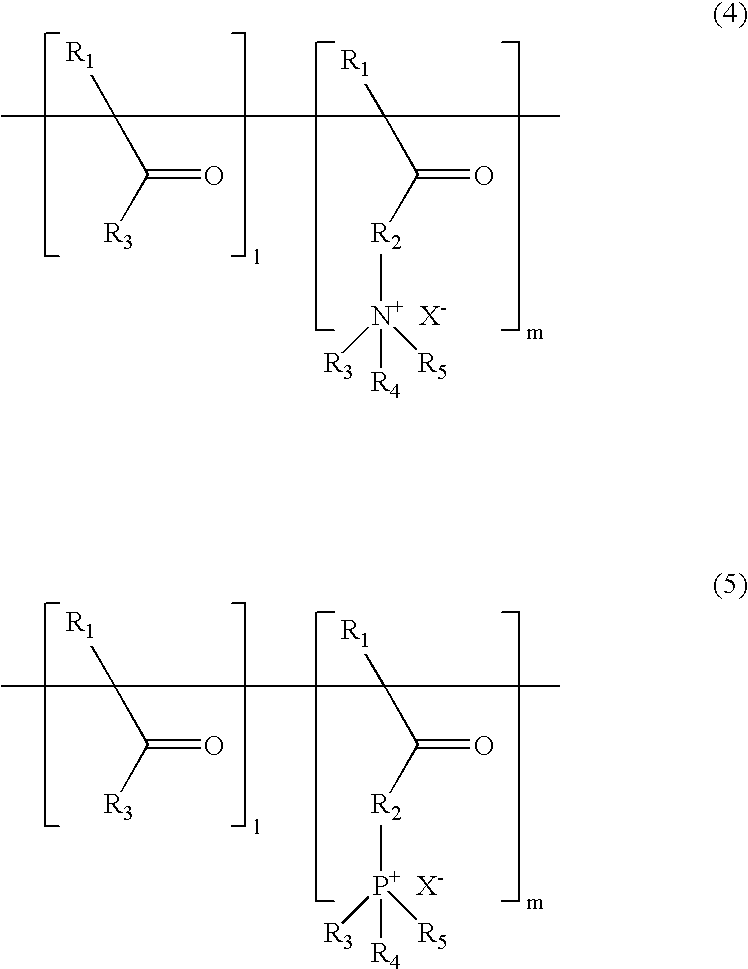Polymer for a photochromic compound matrix, and a matrix comprising the said polymer
a compound matrix and polymer technology, applied in the field of polymer for a compound matrix and a matrix comprising the said polymer, can solve the problems of difficult to form and maintain the uniformity of blending, limited in public use, and the use of liquid crystal compound as mirrors, etc., to achieve easy and uniform blending, excellent color changing properties and restoring rates
- Summary
- Abstract
- Description
- Claims
- Application Information
AI Technical Summary
Benefits of technology
Problems solved by technology
Method used
Image
Examples
examples 1-3
[0030] Propylmethacrylate(60 g) and methacroxyethyl trimethyl ammonium chloride (20 g) was dissolved in the solvent prepared by mixing ethylacetate with ethanol (1:1), and then 1.5 g of 2,2′-azobisisobutyronitrile(AIBN), a radical initiator, was added thereto, and it was reacted as heating and agitating it for 24 hours at 60° C. under nitrogen atmosphere. Then, the reaction was terminated by adding 0.5 g of 0.1N hydrochloric acid thereto and agitating it for 1 hour at the room temperature. Thereby, the polymer of the formula (4), in which the ratio of acrylate monomer containing ammonium of the said formula (1) against propylmethacrylate having acrylate structure of the said formula (2) was 1:3, was manufactured (Example 1).
[0031] As a result of measuring the molecular weight of the polymer manufactured by using GPC (ALLIANCE G, WATERS), its value was found to be 15,000.
[0032] The polymer of the formula (4) to be used as a polymer supporter was manufactured by mixing propylmethacr...
examples 4-6
[0040] For synthesizing the vinyl monomer containing phosponium salt of the said Formula 3, the reaction was made to progress by agitating vinyl benzyl chloride (22.5 g) and tributyl phospine (30 g) at the normal temperature for 24 hours under nitrogen atmosphere, and after completion of the reaction, vinylbenzyltributylphosphonium chloride was synthesized by re-crystallizing it with etlylacetate.
[0041] Methymethacrylate(60 g) and vinylbenzyl tributyl phosphonium chloride (20 g) synthesized according to the said process were dissolved in ethylacetate, and then, 1.72 g of AIBN, a radical initiator, was added thereto, and while it was heated and agitated at 60° C. under nitrogen atmosphere, the reaction was made to progress for 24 hours. Finally, 0.1 g of 0.1N hydrochloric acid was added thereto, and the reaction was made to be terminated by agitating it for one hour at the normal temperature. Thereby, the polymer of the formula (5), in which the ratio of vinyl benzyl tributyl phosph...
PUM
| Property | Measurement | Unit |
|---|---|---|
| temperature | aaaaa | aaaaa |
| thickness | aaaaa | aaaaa |
| reflectance | aaaaa | aaaaa |
Abstract
Description
Claims
Application Information
 Login to View More
Login to View More - R&D
- Intellectual Property
- Life Sciences
- Materials
- Tech Scout
- Unparalleled Data Quality
- Higher Quality Content
- 60% Fewer Hallucinations
Browse by: Latest US Patents, China's latest patents, Technical Efficacy Thesaurus, Application Domain, Technology Topic, Popular Technical Reports.
© 2025 PatSnap. All rights reserved.Legal|Privacy policy|Modern Slavery Act Transparency Statement|Sitemap|About US| Contact US: help@patsnap.com



